Driving in Morocco is a fascinating adventure. The journey unfolds like a series of vivid snapshots, showcasing the rich tapestry of local life where bustling villages sprout from the desert only to be replaced by long stretches of asphalt weaving through barren rocky landscapes home to withered trees, shepherds and goatherders. Amidst this desolate scenery, it’s not uncommon to spot rogue goats perched in trees and stray dogs ambling along the roadside. Men in traditional dress guide donkeys laden with fresh produce and wizened old men lounge in collapsible chairs by the roadside extending invitations to stop and explore their offerings of bottles of argan oil.
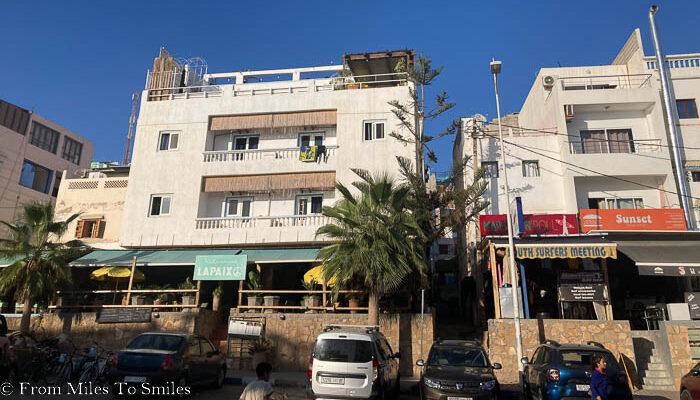
The landscape is hugely diverse. From rugged plains framed by the majestic peaks of the Atlas Mountains to coastal roads skirting pristine beaches, where colossal waves batter the shore. Each turn of the wheel presents a different facet of Morocco’s captivating landscapes. Driving through Morocco is a vibrant kaleidoscope of daily life where trucks transporting cows on their roofs is just par for the course. You will also witness the Moroccan National pride with frequent flags in a deep burgundy hue embellishing roundabouts and the roadsides of quaint towns and villages.
In every mile travelled, Morocco unfolds its unique charm, offering a visual feast that goes beyond the conventional tourist experience. The road is a pathway into the heart of this North African gem, where tradition meets modernity against a backdrop of ever-changing landscapes.
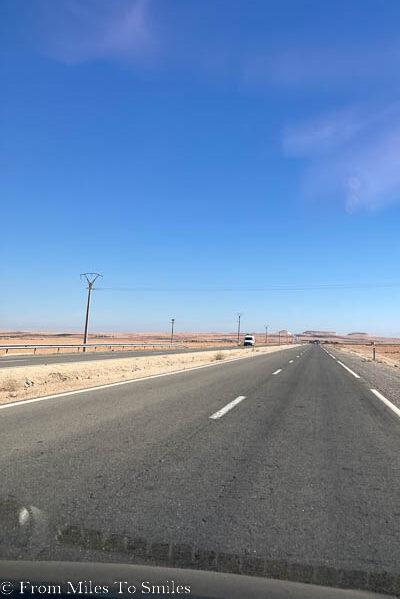
While the allure of driving through Morocco is undeniable however, you will need to plan to ensure a stress-free journey. Pay heed to these eight crucial tips to avoid potential driving dilemmas and disasters. That way you can fully relish your driving adventure.
8 tips for safe driving in Morocco
Tolls
The first thing to be aware of is that the main motorways are toll roads. Some booths may accept credit card but for a stress free journey you should ensure you have sufficient cash to pay any tolls. ATMS are readily available in towns and cities but if you pick up a hire car at the airport, it makes sense to withdraw money at the cash machine in the airport.
Here are the main motorways in Morocco with tolls. For ease an A road will have tolls but any N roads do not.
- A1 Casablanca-Rabat (86 km)
- A1 Casablanca–Safi (255 km)
- A2 Rabat-Fes (190 km)
- A2 Fes-Oujda (306 km)
- A3 Casablanca-Marrakesh (220 km)
- A3 extension to Agadir (233 km)
- A4 Berrechid-Benni Mellal (172 km)
- A5 Rabat-Tangier Med (308 km)
- A7 Tetouan-Fnideq (28 km)
Our experience on the toll roads
The A3 is the only toll road that we travelled. It is dual carriageway so allows for greater speed than the winding, single file N roads. Toll costs are reasonable and can be found here. A car is Class 1. Note, it can be quite difficult to figure out the costs of travel as the names on the price list do not correspond with the town, nor are they clearly marked on the motorway map. The easiest option, if you need to know the exact cost, is to Google your start and end points.
For example, the toll booth for Agadir is Amskroud and the booth for Marrakesh Airport is Palmarie. The distance is 233km and it costs around 91 Dirhams or about £7. Note, however the journey from Essaioura to Marrakesh is around 180Km all of which can be completed on N roads thus avoiding tolls. In other words, you can avoid the tolls but your journeys will take longer.
Road conditions
The road conditions are generally very good with well paved roads. Apart from dual carriageway motorways however, most roads are single file roads that weave around twists and turns, up and over mountains in a delightful dance. Whilst beautiful, you need to allow significantly more time for your journeys than you might expect.
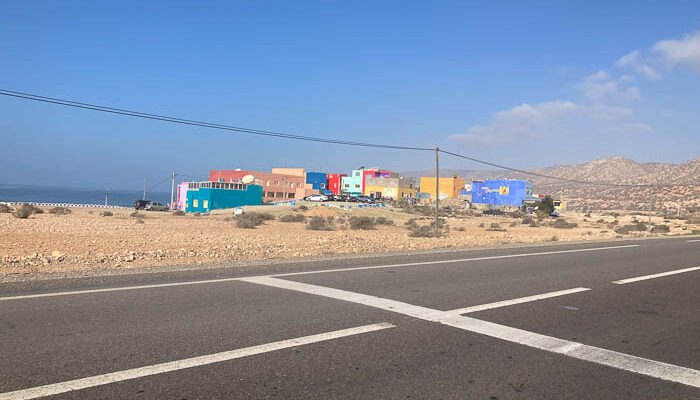
On the N1 for example, you should allow 3 hours for a 150km journey, especially if you have time sensitive plans.
Speed cameras
This is one of the biggest hazards you will come across in Morocco. Not only do many towns have radar speed traps – grey boxes with a solar panel on a pole – but police are everywhere! And I really do mean everywhere. Police in a variety of uniforms wait to catch unsuspecting speeders and we saw numerous tickets being handed out.
To give you an idea of how prevalent they are, travelling the coast road between Taghazout and Essaouira (about 150km) we passed 5 or 6 police patrols running speed checks. They commonly camp out on roundabouts or in the shade of roadside trees. Ignore speed limits at your peril.
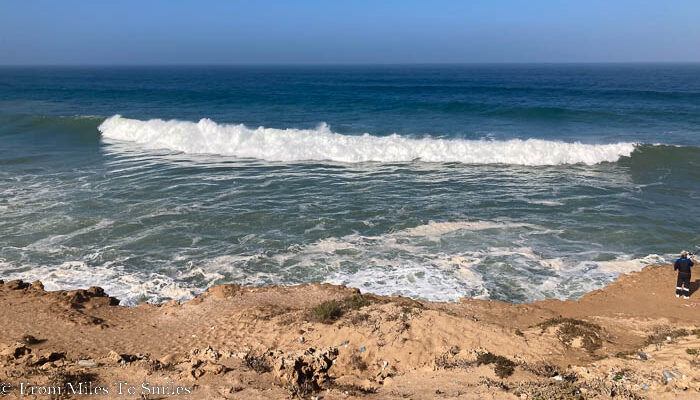
Crazy drivers
Strangely, dangerous driving does not warrant a driving ticket. Perhaps, because it is so prevalent it would be impossible to police. This is a very serious hazard in Morocco and you need to keep your wits about you. Drivers rarely use their indicators, cars hurtle onto roundabouts without a hint of caution and drivers frequently try kamikaze overtaking manoeuvres on corners, cliffsides and in towns.
With this in mind, driving at night is best avoided.
Nonchalant pedestrians
In the heart of the city, individuals draped in flowing, long robes with elevated pointing hoods nonchalantly stroll through bustling streets. As onlookers, we grapple with the enigma of whether these figures are adorned in tribal regalia or if their attire serves a practical purpose, perhaps shielding them from the relentless sun. Regardless there is no concept of ‘the green cross code’ with pedestrians ambling into the road and even stopping to chat to their friends.
Stray animals
Another hazard to contend with in Morocco comes in the form of stray animals. This includes laid-back dogs meandering onto the road, some even finding repose on the asphalt. In addition to dogs, you might encounter goats, cats, cows, donkeys, and, of course, the occasional human strolling casually into the middle of the road, seemingly indifferent to the traffic around them.
Each encounter is a fascinating testament to the unique challenges posed by the eclectic melee of daily life in Morocco.
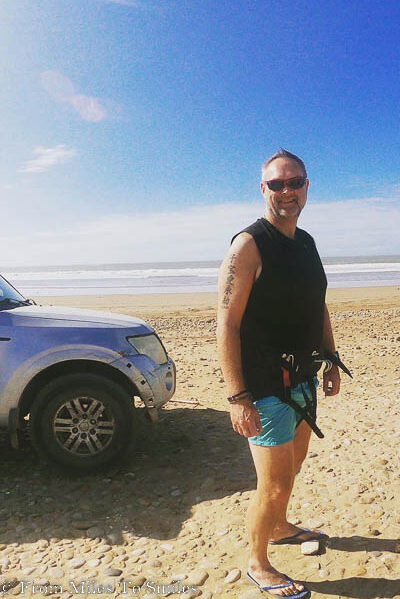
Off roading
Generally, it is not wise to take your hire car off road. However, if you book activities along the coast, it’s not unusual to navigate off road to reach your destination. You may need to weave through sand dunes to reach the beach or explore destinations slightly off the main road. Drive slowly and exercise caution, keeping a keen eye out for soft sand, water, and any other obstacles that could potentially land you in hot water.
Trash
Stay vigilant, as discarded trash is frequently strewn across the road and poses a genuine hazard to you and your vehicle. If you spot bags or boxes in the road, aim to avoid them where possible as it is not out of the norm for glass bottles to be casually dumped in the middle of the road.
Parking
Parking fees are a common occurrence in most cities and towns. Even if you park by the roadside without any clear payment instructions, magically a vest clad person will appear to request payment. Typically, in towns, the charge is 8-10 dirhams for as long as you wish to stay.
Our highest hourly parking fee was 8 dirhams at the Agadir Cable car. (GYG LINK) Meanwhile, in Essaouira, parking costs 20 dirhams for a 24-hour period. This is a pretty sweet deal especially when your parking spot offers views like this.
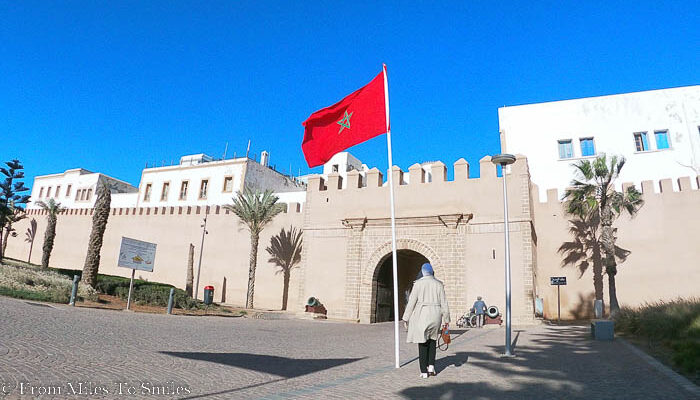
Have you ever driven in Morocco?
Despite the hazards, hiring a car on our trip was part of what made the trip so much fun. Maybe you have hired a car in Morocco and if so we would love to know how you found it?
 From Miles to Smiles Stylish travel for professionals seeking luxury at affordable prices
From Miles to Smiles Stylish travel for professionals seeking luxury at affordable prices

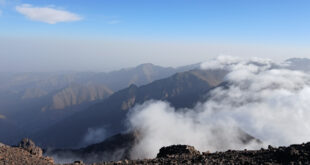
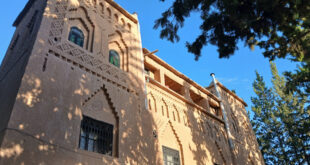
Captivating read! Morocco’s vibrant landscapes and essential driving tips make me eager to embark on my own adventure. Thanks for the inspiration!